Mithridates VI Eupator, the great ruler of the Pontic kingdom and one of the most implacable enemies of Rome, left so many questions to historians that their final solution is probably almost as far from completion today as it was when the study of his turbulent life began. One of these problems is determining the place of this king among other rulers of the Hellenistic east. After all, Mithridates VI differs markedly both from the “classical” Hellenistic kings, and from the Parthian or Armenian rulers. This question has been raised in historiography more than once, but its many facets force us to return to it again and again.
In one of his recent works, the largest modern scholar of the history of Mithridates Eupator B. Macking expressed the opinion that prevails now in science and coincides with his personal opinion on this issue: “The Hellenism of Eupator includes so many aspects that we cannot resist the temptation to think as if he and his family had become a Greek dynasty in all respects, to doubt whether the kingdom of Mithridates had become a Greek monarchy in all respects. I would like to emphasize here that the Iranian principles continued to retain their significance throughout the reign of Mithridates Eupator. "
While generally agreeing with this view of the problem, the author of this article still sees a number of aspects that need to be analyzed in more detail in order to identify the ideas of Mithridates VI himself and his attitude to his Iranian roots and Hellenistic borrowings. Most clearly, in our opinion, these aspects will be seen when analyzing the available evidence about the family of the Pontic ruler. Moreover, it is about his family, since the earlier strata associated with the ancestors of Mithridates VI, as not related to his will and actions, will remain outside the scope of this study.
Wives of Mithridates VI Eupator
According to the marriage tradition established in the Pontic kingdom, local monarchs chose their wives from among their sisters or Seleucid princesses, usually bearing the name Laodice (2). Kinship with the Seleucids, of course, increased the international authority of the country and the degree of Hellenization of the Pontic court, which naturally affected the marriage sphere. Marriages with sisters were also not a sign of barbarism, Lagids, for example, whom no one ever called barbarians, used this custom very often (3), this form of marriage was practiced in ruling house Seleucids.
Mithridates VI Eupator also did not depart from this tradition: it is known that he married his sister Laodike. It is possible that before marriage this princess was called differently. The fact is that Mithridates VI also had another sister named Laodice (see about her below), and therefore it is unlikely that in one family the children were called by the same name at the same time; it is difficult even to give such an example.
The marriage of Mithridates VI Eupator and his sister Laodice, apparently, was a possible compromise between the king and the opposing palace group led by his mother, a group driven out of power, but not yet completely defeated. The marriage was concluded on the basis of the age of Mithridates VI, after the deprivation of power by the widow of Mithridates V Everget. Getting a sister in marriage, Mithridates VI (perhaps, on the contrary, his opponents) wanted to see her as the eldest woman of the Pontic royal house, and this one traditionally bore the Seleucid name of Laodike. For that era, the name had tremendous propaganda significance: for example, by changing the name alone, Mithridates VI and Nicomedes III gave legitimacy to power to their own children seated on the throne of other countries (Cappadocia and Paphlagonia, respectively). This probably explains the presence in the sources of two daughters with the same name from one father, and possibly one mother, since they (Laodice) both of them became queens, and therefore both were legitimate royal daughters (5).
This version can be confirmed by the plot about the betrayal of Laodice the Younger to Mithridates VI Yevpator, an attempt to poison him and the subsequent execution of her and other perpetrators. A conspiracy, real or invented, is clearly visible here, the result of which was the execution of those guilty or disliked by the tsar. Moreover, there is a version according to which the very trip of Mithridates VI across Asia, during which these events began, was caused by the weakness of the king, who was actually ousted from his palace. From the messages of Justin and Sallust, it follows that Laodice was executed, but there is an opinion in historiography that this is not so, and the message about the execution of Laodice is a consequence of the pro-Roman literary tradition hostile to Mithridates VI (6). In any case, after the death of Laodice, Mithridates VI, Eupator does not choose another sister for his wife, although, as is clear from the sources, he had them, and, most likely, at least some of them were at the age when they could still have children (see below for more details).
The son of Mithridates VI and Laodice, reported by Justin, according to T. Reinak, was the future king of Cappadocia - Ariarat IX (7). Ariarat IX was born - however, at birth he also probably received a different name - in 109/108 BC, and at the age of eight he became king of Cappadocia, that is, in 100/101 BC ( eight) . This Ariarat helped Mithridates VI in the war for Cappadocia, and was later poisoned by him.
T. Mommsen in his vivid portrait of Mithridates VI gives a short but very characteristic remark about the king's harem, seeing this as one of the signs of his Asian way of life (9). T. Reinak compares the ginekey of Mithridates VI with the Sultan's seraglio, likening the difference in the status of wives and concubines to the differences in the status of sultans and concubines established in the harems of Turkish sultans. Most of the subsequent authors accepted this point of view without objection or passed it by.
However, it should be noted that all the other wives of Mithridates VI, except Laodice, were Greek, and none of them came from the royal family. The king practiced marriages with commoners, as was customary among the Pergamon Attalids (10). Apparently, Mithridates VI wanted in this way to get the support of the citizens of the policies that were previously part of the Pegama kingdom, and now located in the Roman province of Asia.
So, from sources we know the names of five women of Mithridates VI, whose status is either exactly royal, or close to him:
1. Laodike (about her see above); 2. Monima; 3. Stratonica; 4. Berenice; 5. Hypsycracy. Let's analyze all the available information about them.
Monima from Stratonikea. As Plutarch reports about Monima: “... when at one time the king sought her favor and sent her 15,000 gold pieces, she refused everything until he signed a marriage contract with her and proclaimed her queen by sending a diadem” (11 ). Monima's father Philopemenos became an “observer” (bishop) over Ephesus, which, apparently, was one of the conditions of the marriage contract. During the anti-Mithridates uprising in Ephesus, Philopemenos most likely died, since we no longer have news of his activities. The marriage between Mithridates VI and Monima took place, apparently, around 88 BC, during the period of the king's greatest successes in the first war with Rome.
The king's feelings for Monima were probably really strong; This is also confirmed by the testimony of Plutarch about the "obscene" correspondence between the tsar and his wife discovered by Pompey in the New Fortress.
The further fate of Monima is sad: so that she does not fall into the hands of the Romans, she is killed by order of the king.
Stratonik. Unlike Laodice and Monima, whose status can be accurately identified as royal, Stratonica's position is unknown. Plutarch calls her a concubine, Appian does not know whether she is a concubine or a wife, Dio Cassius calls her wife.
Stratonica, which replaced Monima in the heart of the king, was completely not a noble family. Talking about her acquaintance with the king at a feast, Plutarch emphasizes the baseness of her family and does not even mention the name of her father, and our other sources are silent about this. The city from which she came is also unknown.
It is all the more surprising in this regard that Mithridates entrusted Stratonica with the administration of the fortress with the treasury. Stratonica handed over the fortress and treasures to Pompey in exchange for a promise to save the life of her son from the king, Xifar. Mithridates, having learned about this, in order to punish the traitor, executed Xifar. According to T. Reinak, the act of Stratonica is explained by jealousy of the position that she occupied near the king of Hypsikratia (12).
The further fate of Stratonica is unknown to us, however, given the fact that Pompey left most of the treasures of Mithridates VI in her property, it would not be an exaggeration to say that she spent the rest of her life in abundance.
Berenice of Chios. Her name is only mentioned in Plutarch's text. Describing the tragedy in Pharnacia, when the king's wives and concubines killed themselves on his orders so as not to fall into the hands of the Romans, Plutarch also reports about the poisoned Berenice and her mother.
Gypsycracy. We know about this woman that she accompanied Mithridates VI after his defeat at the hands of Wrath Pompey. Hypsycratia was dressed like a Persian warrior and behaved accordingly, caring for the king and his war horse. Plutarch calls her a concubine, Valery Maximus, Eutropius and Festus, who rely on him, the king's wife.
Her functions under the king were so unusual that Mithridates VI called her not Hypsicracy, but Hypsicrates. This circumstance, as well as a hint of the Tsar's sympathy for the beauty of the young man, even made it possible to make an assumption about the unconventional orientation of the Pontic ruler, which seems to us absolutely incredible.
According to Valery Maxim, Gipsikratia accompanied the tsar during his campaign to the Bosporus, but then the traces of her fate are lost. From the work of Orosius it is known that before dying, Mithridates VI gave poison to his wives and concubines, but whether Hypsycratia was among them, we do not know.
The image of Gypsikratia, found in the works of ancient authors, is close to the image of the mythological female warriors of the Amazons; Perhaps this is due to the tendency of Mithridates to imitate Alexander the Great, who, as is known, according to legend, married the queen of these warriors.
So, Stratonica, Berenice and Hypsicratia - who are they: wives or concubines? The analysis of the sources rather inclines us to the second version. It is this status that Plutarch determines for them, who, as you know, relied, describing the Asian company of Pompey, on the work of Theophanes of Mytilene. In this case, this source is reliable for us, since Theophanes accompanied Pompey on this campaign and was undoubtedly aware of these details. Doubt is only caused by Stratonica, to whom the tsar entrusted strictly classified information about the secret treasury (for more details, see above). The answer, it seems to us, is in Appian, who says that Mithridates "being so prudent and hardy, had only one weakness - in pleasures with women."
Of course, in addition to the five above-mentioned wives (concubines), Mithridates VI entered into rather long-term love unions with other women. So the sources tell us about a certain Adobogion, the concubine of Mithridates VI and, possibly, the mother of his son, known as Mithridates of Pergamon. Judging by the name, this Adobogion, Galatka, was later the wife of the Galatian tetrarch Menodotus (13).
There were also other concubines whose names are unknown; they were the daughters of the noblest people of the kingdom, it was them who were freed and sent to their relatives by Pompey. Appian says that "the eunuch Bakch ... killed his (Mithridates - KG) sisters, wives and concubines." Plutarch also reports about the “Scythian wives” of Mithridates VI, who were carried out in the triumph of Pompey. According to Orosius, some wives and concubines of Mithridates died with him. If we consider that the information about the wives and concubines of Mithridates VI mainly refers to the period of the end of the Third Mithridates War, then we can safely assume the presence of many others, information about which either did not reach us, or did not enter history at all.
There were, apparently, and children of Mithridates VI from concubines, but they were not considered legal. This is exactly what Mithridates of Pergamon, the son of Adobogion, should be, as well as Archelaus, the son of the eponymous Pontic strategist, who claimed that he was in fact the son of Mithridates VI Eupator. Count based on state of the art sources that their father was precisely Mithridates Eupator, as well as the opposite, is unsubstantiated.
As we can see, in the matter of choosing wives, Mithridates VI focused on women of non-royal origin (14). Apart from his sister Laodike, he did not enter into a marriage alliance with any princess. Apparently, the support of the Greeks of the Roman province of Asia, from which his wives came, was more important to him than alliances with Bithynia, Egypt, Parthia or any other kingdoms. Perhaps Mithridates VI Eupator did not want to receive a wife from the hands of her relative - the king, since, in this case, becoming his son-in-law, he seemed to fall under someone's, even purely nominal, power.
Polygamy, however, is characteristic not only of the Pontic ruler, moreover, here a direct analogy suggests itself with Alexander the Great, whom Mithridates VI Eupator sought to imitate in everything, and even the Macedonian royal house in general.
The author of this article is more inclined to the version according to which Mithridates VI Eupator was so loving for women that he proceeded in matrimonial matters solely from his own desires, and not some far-sighted political calculations. This circumstance brings him closer to the classical Hellenistic monarchs, many of whom also had a significant number of mistresses, but never more than one (of course, at the same time) main wife, who came from an influential royal house. The resettlement of these women in a guarded palace looks absolutely natural, and most likely the same practice existed in other royal courts of the Hellenistic world; therefore, it is unfounded to see this as something typically Oriental (15).
Sisters of Mithridates VI Eupator
Ancient authors brought to us the names of the five sisters of Mithridates VI: 1. Laodicus I; 2.Laodice II (about her see above); 3. Roxanne; 4. Statira; 5. Nisa.
Laodice I is the wife of the Cappadocian king Ariarat VI. The exact date and circumstances of this marriage are unknown. It is traditionally believed that he followed the invasion of Cappadocia by Mithridates V Everget mentioned by Appian (16). According to Pompey Trogus, Laodice I, after the death of her husband, ruled together with her son Ariarates VII, then she married the Bithinian king Nicomedes III (17) and helped him capture Cappadocia. After the invasion of the country by the troops of Mithridates, she was apparently forced to go to Bithynia to her new husband (18).
Roxanne and Statyr. It is known about them that they were hiding in Pharnacia, when Mithridates, fearing that they would fall into the hands of the Romans, ordered them to die. The king did not give them in marriage and they “sat up with girls until they were forty” (19).
Nisa. Another sister of Mithridates VI was imprisoned by him in one of the fortresses and freed by Lucullus. Perhaps it was she who was subsequently carried out in the triumph of Pompey, although this is surprising: after all, having freed Nisa, Lucullus was supposed to lead her in his triumph. Therefore, it is possible that Mithridates also had a sixth sister, who bears a name unknown to us.
Thus, we see that Mithridates VI did not marry any of his sisters, moreover, most likely, during his reign, they were isolated from the court. The reason for this apparently lies in the personal characteristics of the Pontic ruler, who suffered great troubles from his two sisters (Laodice I and Laodice II). Here we see "Eastern despotism" more clearly, but in both Syria and Egypt, the sisters of the monarchs were completely dependent on their will.
Sons of Mithridates VI Eupator
Ancient authors brought to us the names of the eleven sons of Mithridates VI Eupator: 1. Artaphernes; 2. Mahar (21); 3. Pharnaces; 4. Xifar; 5. Darius; 6. Xerxes; 7. Oksatr; 8. Mithridates the Younger; 9. Arkathiy; 10. Excipient; 11. Ariarat (about him, see above).
As we can see, the sons of Mithridates Eupator, unlike his wives, all have Persian names. This fact speaks in favor of the dominance of Orientalism in the family of the Pontic king, but perhaps this is just a tribute to the religious tradition.
The four younger sons, captured in the rebellious Phanagoria, have traditionally Persian names: Artaphernes, Darius, Xerxes, Oksatr. Since they received their names during the heyday of the activities of Mithridates Eupator, it can be concluded that the names were given to them for the Iranians, and not for the Greeks, for whom they could act under any Greek epithets, similar to those that Mithridates Eupator himself had. ...
During the first war against Rome, Mithridates the Younger, Arkathius and also Ariarates were already adults. They were probably followed by Artaphernes, born in 104 BC. e., Mahar and Pharnace, born in 97 BC. and Xifar. Finally, there followed the sons captured during the rebellion in Phanagoria. After this rebellion, Mithridates killed his other son, Exipodrus: information about this is reported by Orosius, while other authors do not report about him. We don't know much about Artaphernes, but he is nonetheless mentioned in Pompey's triumph.
As irrefutably follows from the sources, the princes are used as they grow up in administrative and military positions. Mithridates Eupator even transfers part of his powers to them when he is away. Mithridates seeks to suppress dynastic strife. However, there are indications to suspect such things have happened. We know from Plutarch that while Mithridates was in Pergamum, he appointed one of his sons as ruler of other territories, to whom Pontus and the Bosporus were allocated. It was probably Mithridates the Younger.
Firstly, it was he who took the father's name, traditional for the dynasty, which was no longer accidental, and could indicate his status as heir. Secondly, Mithridates the Younger was near his father in Asia and fought against Fimbria while the other eldest son Arkathius was in Greece.
You can try to calculate which of the wives of Mithridates Eupator was the mother of one or another of his children, comparing the year of the king's marriage with them and the year when he took a new wife, but this method is hardly quite reliable for reconstruction.
Daughters of Mithridates VI Eupator
Mithridates VI used his numerous daughters, as was customary at that time, “for their intended purpose,” that is, he gave them in marriage to his allies, thus securing the political contract by marriage. Mithridates VI became the father-in-law, and therefore the eldest in the alliance, which naturally increased his international authority. In addition, the transfer of her daughter to her new master - her husband, apparently, was regarded as a very valuable, truly royal gift: after all, the value of a woman descended from such a powerful ruler was immeasurably higher than any other. As we will see, Mithridates VI used all these aspects of marriage very skillfully, acquiring large political dividends in return for his daughter. In this regard, one cannot but agree with the statement of the Spanish researcher L. Ballesteros Pastora: “With regard to the daughters, we can conclude that Mithridates used them as an instrument in his foreign policy”.
Mithridates VI, was well aware that his daughters are his capital; this is evident at least from the fact that, leaving his wives and sisters in Pharnacia, which was subsequently captured by the Romans, he took his daughters with him to the Bosporus.
In total, Mithridates VI had 8: 1 daughters known to us by name from preserved ancient sources. 2. Cleopatra I. 3. Athenais. 4. Mithridatis. 5. Nisa. 6. Cleopatra II. 7. Evpatra. 8. Orsabaris.
Dripetina. The year of her birth is unknown to us, but, apparently, this is the eldest legitimate daughter of Mithridates VI, since Valery Maxim reports that she was born to Laodice, the king's sister-wife. Due to illness, Dripetina was left by Mithridates VI in the fortress of Sinoria under the supervision of the faithful eunuch Menophilus. The betrayal of the garrison of the fortress, which opened the gates of the legate of Pompey Manlius Prisca, forced Menophilus to kill Drepentina, and then himself, so as not to fall into the hands of enemies
Cleopatra. Cleopatra was married to the king of Armenia Tigran II in 94 BC. We do not know the year of her birth. An alliance with Tigranes II, sealed by marriage, turned out to be very beneficial for Mithridates VI. As for Cleopatra, she most likely had a rather influential position at the court of her husband.
Athenaida. Next in seniority, we know the daughter of Mithridates VI, who was betrothed to the king of Cappadocia Ariobarzanes I. Appian reports: “Considering it unacceptable that a war is being waged against Mithridates, who concluded a treaty with the Romans, Sulla sent Aulus Gabinius to convey to Murena the previous strict order not to fight with Mithridates, and reconcile Mithridates and Ariobarzanes with each other. At this meeting, Mithridates married his four-year-old daughter to Ariobarzanes, and under this pretext he agreed to own what was in his hands from Cappadocia, and besides that he appropriated other parts of this country, treated everyone and appointed everyone monetary rewards for the best toasts, treats , jokes and songs, as he usually did. Only Gabinius alone did not touch anything. So the second war of Mithridates with the Romans ended in about the third year ”.
Apparently, the young daughter of Mithridates VI was married not for the old man Ariobarzanus I, but for his son and heir Ariobarzanus II, since from Cicero's letters we know that the mother of Ariobarzanes III was the daughter of Mithridates VI - Athenais. This marriage, like the marriage of his other daughter, Cleopatra, brought Mithridates VI good political dividends in the form of some part of the territory of Cappadocia.
The engagement, judging by the text of Appian, took place at the very end of the Second Mithridates War in 82 BC. The name of the princess refers to Athens, who sided with Mithridates VI. Mithridates VI could call his daughter Athenais only before their fall, which occurred on March 1, 86 BC. Consequently, and this also fits the testimony of Appian, Athenais was born in winter - in the spring of 86 BC.
Miridatis and Nissa. They were to marry the Lagids, the kings of Egypt and Cyprus, respectively. But the marriages, due to the defeat of Mithridates VI in the war with Rome, did not take place. Both daughters were with their father until the last moment and in 63 BC. poisoned so as not to fall into the hands of the Romans.
Cleopatra II. It is known about this daughter of Mithridates VI that she was in Phanagoria at the time of the uprising of this city against the king. However, unlike the other children of the king, she was not taken aback and resisted the rebels. Delighted with her courage, Mithridates sent her help and thereby saved her. The further fate of Cleopatra II is unknown. There is no doubt that this woman is not the Cleopatra who was married to the king of Armenia Tigran II - she is another daughter of the Pontic ruler. She may have received the name after the death of the latter, already as an adult. If this is so, then Mithridates VI was preparing her for marriage with one of the “strong” kings, giving her a more significant weight by changing her name.
Eupatra and Orsabaris, which were held in Pompey's triumph. It is possible that Orsabaris was captured, along with other unnamed daughters of Mithridates VI, whom he sent as brides for his future Scythian leaders - allies. In the current political situation for Mithridates, it would have been a very successful alliance. But the warriors accompanying the princesses gave them to the Romans. Evpatra was captured and also surrendered to the Romans by the rebellious Phanagorians led by Castor.
A number of the names of the daughters of Mithridates VI are Greek, a number are Persian, some are formed from his names (Mithridatis and Eupatra), symptomatic is the absence of the name Laodicus. This, apparently, is due to the desire of the king to mix the names and be equally “his own”, both for the Greeks and for the indigenous population of Pontus. Unlike the sons of the king, who have exclusively Persian, mainly royal names, the Greek names of his daughters are of purely Seleucid origin.
Other relatives of Mithridates VI Eupator
It is interesting that the name of the only known relative of Mithridates (24), who was not in the first degree of kinship with him, is Greek - Phoenix. This man commanded the vanguard of the army of Mithridates against Lucullus, and then went over to the side of the Romans. This message from Appian, leads some modern researchers to the idea that other relatives of the king could occupy high military and administrative posts. This is also confirmed by the fact that the father of one of the wives of Mithridates - Monima Philopemenos became an “observer” (bishop) over Ephesus. systems of government of the most classical Hellenistic states.
Summing up this study, it can be noted that the family "policy" of Mithridates VI Eupator, in general, was traditional for the Hellenistic rulers, although it had some distinctive features caused not so much by the "orientalism" of the king, but by his personal characteristics, which, of course, were largely based on his Iranian roots. For us, it is important that in the eyes of the Greeks, Mithridates, in terms of his family affairs, looked almost the same as other classical Hellenistic monarchs.
(born 132 BC - died 63 BC)
King Pontus, who subdued the entire Black Sea coast, was a consistent enemy of the Roman Empire, who fought three wars with it.
“Mithridates, the king of Pontus, a man who can neither be passed over in silence, nor talk about him without attention, sophisticated in war, glorious in valor, and sometimes in military happiness, always great in spirit, a leader in plans, a warrior in battle, in hatred of the Romans Hannibal ... ”- wrote the Roman historian Vellei Paterculus. It is difficult to add anything to these words. When describing the life path of Mithridates, the association with Hannibal arises by itself. For all the difference in place, time and circumstances, the similarity in principled positions is surprising. Both - for different reasons - received a Spartan upbringing and became warriors, warriors with lofty goals. It was these ambitions, and not the pathological hatred of Rome, as Roman historians liked to write, that guided them both in choosing a worthy opponent, and this could only be Rome. Both Hannibal and Mithridates, having achieved victories over Rome and having received recognition of their valor from the Romans themselves, did not stop. Despite the fact that Rome tacitly closed its eyes to its defeats and did not prevent them from expanding their interests in other directions - Hannibal in Africa, Mithridates to the south and east of Pontus - both were defeated and fled to Armenia.
Hannibal and Eupator were in good health, both mental and physical. Both lived a full life until old age, both of their own free will passed away at the turn of the 70th anniversary.
The Mithridatic wars provide ideal material for studying war as a social phenomenon and as a philosophical concept. All the factors of war - political, social, material, geographical and personal - are fully present in them - new tactics and grandiose betrayal, a revolution in weapons and personal courage, colossal sacrifices and commercialism. And each of these factors at a certain stage became decisive and led to victory or defeat.
Mithridates VI Eupator was born in 132 BC. NS. in Sinop. His father was Mithridates V Everget, a direct descendant of Ariobarzanes, a satrap of Helleosponian Phrygia, an associate of Darius I. His mother was Laodice, daughter of King Antiochus IV Epiphanes from the Seleucid dynasty. Everget was killed in his palace by conspirators, obviously not without the participation of his wife. Laodike aspired to power and wanted to put on the throne the youngest son, nicknamed Christ the Good. These circumstances forced the young Mithridates to hide in the mountains of Pariadr, where he trained mind and body for 7 years. According to various sources, Mithridates came to power in the period from 120 to 111 BC. NS. The most probable is 113 g. Apparently, the throne did not come easily to him and not immediately. As is customary among tyrants, Mithridates first stabbed and poisoned some of the closest relatives, including his mother and brother, and later sent to better world half of the Pontic aristocracy. All of these activities showed the surviving elite who truly deserves to be king of Pontus.
Having established himself in power, Mithridates married his own sister Laodike (later he would poison her too) and took up state affairs. He annexed Colchis to Pontus, after that Lesser Armenia was captured, and the turn came to the Crimea. Roman historians note the annexation of the Bosporus kingdom to Pontus in passing, as a threshold to the main events, and this was the main thing for Mithridates. Back in 179 BC. NS. Chersonesos and the king of Ponta Pharnaces I concluded a treaty containing the obligations of Pharnaces to help the Chersonesos in protection from the Scythians. New pressure of the Scythians on Chersonesos at the end of the II century. BC NS. prompted the Greeks to seek help from Mithridates VI, the grandson of Pharnaces. Mithridates sent in 110 BC. NS. troops under the command of Diophantus in Chersonesos. As a result of two expeditions of the commander, the Scythian king Palak was dealt a crushing blow, the capital of Naples was captured. At the end of the campaign, Diophantus went to the Bosporus and arranged "the business there is wonderful and beneficial for the king Mithridates." He suppressed the uprising of slaves, led by Savmak, made alliances with the free tribes of the Scythians, Bastars and Thracians. The Bosporan king, the last of the Spartokid dynasty, renounced power in favor of Mithridates. In 107 BC. NS. Eupator became the ruler of Chersonesos, Theodosia, Panticapaeum and was called "the king of the Cimmerian Bosporus and the protector of Chersonesos." Tavrida became the bridgehead of Mithridates in the Northern Black Sea region. Gradually, using all the levers - economic, political, power, he spread his influence over the entire Black Sea coast. It gave him everything: money, food, equipment, navy, weapons, army and specialists.
Mithridates planned a "northern" campaign against Rome in alliance with the Scythians and Thracians. The chronicles of Sallust, a contemporary of Mithridates and a citizen of Rome, clearly read the anxiety of the Romans, caused by the strengthening of Mithridates' positions in the Northern Black Sea region. This was the reason for the replacement of Lucullus with Pompey, when the 3rd war, it seemed, had already been finally won. Lucullus held on to his consulate so much that he could not rise above the routine of war and see the problem as a whole. Pompey, with his undoubtedly higher intelligence, was able to. History has confirmed the validity of the expectation of a threat to Rome from the northeast: Tauris turned out to be the main and best acquisition of Mithridates in his entire life.
Having established business in Pontus, Eupator turned his attention to the Roman provinces in Asia Minor. Secretly, with a little escort, Mithridates visited them for an educational purpose. In 108 BC. e., united with the king of Bithynia Nicomedes III, he captured Galatia and Paphlagonia, and then Cappadocia. The king of Cappadocia was the nephew of Mithridates, which did not prevent the conqueror from stabbing him with his own hand with a dagger. The Roman Senate twice demanded that Mithridates liberate the occupied territories, and he obeyed, since the balance of power was in favor of Rome. But he continued to improve relations with the rulers in Near Asia and the Caucasus, conducted deep reconnaissance and agitation in the Roman provinces, and built up his army and navy. "King of Kings" Tigran of Armenia became his son-in-law. Preparation led to the result: in 89 BC. NS. the 1st Mithridates war began, which lasted until 84 BC. NS. Eupator did not forget to fill the war with ideological content - the liberation of Hellenic civilization from Roman despotism.
Asia Minor fell easily to Mithridates. His army, well prepared for expansion, defeated the armies of 4 opponents, which consisted mostly of the militia. The population, exhausted by extortions, surrendered the cities easily and willingly. It was only in the Mediterranean that Mithridates' fleet suffered minor losses from Licinius Lucullus.
In 88 BC. NS. Mithridates, capturing Asia Minor, ordered the extermination of all Italians, including women and children, within 30 days. 80 thousand people died. In Greece, Mithridates' victory in Asia Minor was taken as a signal for liberation. Athens, with the support of Pontus, declared its independence from Rome. Following Athens, most of Greece and Macedonia fell into the sphere of influence of Mithridates. Rome busy civil wars, yet found it possible to send in 87 BC. NS. army under the command of the consul Cornelius Sulla. The Romans landed in Greece and laid siege to Athens. The siege lasted until spring, and, despite the famine, the city was taken only thanks to betrayal: Sulla was shown the place most vulnerable to attack. During the siege, Sulla plundered all the temples of Olympus and Parnassus, cut down the sacred groves of the Academy. And all this time, the fleet of Mithridates was not far away under the command of the best commander Archelaus - it did not leave and did not attack, but simply stood. Mithridates, suspecting something was wrong, sent an army from Thrace and Macedonia under the command of Taxila. Archelaus explained what was in store for Sulla to run out of supplies. In the next two major battles at Chaeronea and Orchomenos, Archelaus, who had three times the army, was defeated, and he himself was captured. Plutarch, giving exaggerated praise to the Romans, could not nevertheless sin against the truth and wrote that rumors about the betrayal of Archelaus circulated in Rome. Sulla, wanting to secure himself a worthy triumph, refuted them in every possible way. Nevertheless, the enemy commander was with him as a guest. The position of an honorary hostage is not new, but Sulla released Archelaus to Mithridates to negotiate peace. But the most interesting thing is that Archelaus returned from Eupator alive. These are already the secrets of big politics. Archelaus frankly sided with Sulla and was Lucullus's advisor in the 3rd war.
In August 85 BC. NS. in Dardan, Mithridates and Sulla discussed the conditions for ending the war. Eupator left Europe and Asia Minor, paid 2 thousand talents and transferred 70 warships to Rome, the parties returned all prisoners. The navy was the price of peace: the Romans needed it. Sulla imposed a fine of 20,000 talents on Asia Minor, and the hostilities ended there.
The 2nd Mithridates' war was needed by one person - the proconsul Licinius Murena, since Rome did not hold office unnecessarily, and in the war he was in power and with money. In 83 BC. NS. Murena moved troops to Pontus. The war lasted until 81 BC. NS. and was significant only in that Mithridates personally commanded the troops. As a result, Murena was defeated and ingloriously returned to Rome, and Mithridates captured Cappadocia, but then returned it at the request of Sulla.
Eupator demonstrated his peacefulness in every possible way during this period, but they hardly believed him: the intelligence of Rome in Pontus worked perfectly. Over the years of peace, Mithridates has created a powerful coalition of the Scythians, Sarmatians, Thracians, Germans. He was supported by Sertorius from Spain, Tigran the Armenian, pirates of Cilicia. At this time, Eupator was developing a plan for a "northern" invasion of Italy. Rome was silent for the time being - partly because Pontus and Armenia were a "buffer" between the Persians and Roman Asia Minor. But the shaky world ended in 74 BC. BC, when the king of Bithynia Nicomedes IV died. He bequeathed his kingdom to Rome. Mithridates declared his support for Sertorius in claiming the throne and invaded Bithynia. The 3rd Mithridates' war began.
The army of Eupator was armed, equipped and trained according to the Roman model and numbered 120 thousand soldiers. The situation of the 1st war was repeated. Mithridates easily captured Bithynia and began fighting in Cappadocia and Paphlagonia. In Asia Minor, unrest began all over the same exorbitant taxes. Rome sent Lucullus and Cotta to the war with Mithridates. Cotta, along with the fleet, arrived earlier and, wanting to secure the laurels of the winner, did not wait for Lucullus to approach. At Chalcedon, he entered into a great battle with the army of Pontus. In the harbor of Chalcedon was the fleet of Rome. In this battle, the army and fleet of Mithridates utterly defeated the Romans. Cotta himself locked himself in Chalcedon and awaited help from Lucullus. The warriors of Lucullus asked him to leave Cotta for his mediocrity and go to Pontus, but he went to Chalcedon. Seeing the army of Mithridates and its weapons, Lucullus did not dare to fight. Mithridates, realizing that there would be no battle, went to besiege Kizil. Lucullus, deciding to win the war by hunger and harassment, attacked separate detachments of Eupator. The element did its part: the hurricane scattered the siege weapons at Kizil, and the storm destroyed the fleet of Mithridates. The army of Eupator, without fighting, lost people; famine began, followed by riot, panic and flight. Mithridates himself was able to escape in a light pirate ship.
Gradually, hostilities moved to the territory of Pontus, and then to Armenia. Tigran spoke with Mithridates. The exhausting tactics of Lucullus turned against him: the legionnaires grumbled, and then completely ceased to obey. They did not want to go to the Caucasus, and Mithridates very quickly recovered and in fact still ruled Pontus. But this war revealed the complete failure of Tigran and his large army. For the Romans, it seems, this was not news: they were the first to attack, even with a tenfold superiority of the enemy, and the Armenians fled in panic. Rome was dissatisfied with the dragging out of the war, Lucullus was removed from command and recalled to Rome, and with him some of his commanders. Pompey took command.
With the elite legions, he sought a meeting with Mithridates. After Eupator set up his camp on the banks of the Euphrates, Pompey decided to attack him at night. But when he approached the camp and saw the battle formations of Mithridates, ready for battle, he decided to abandon the battle. The commanders began to persuade them not to do this: the flawed moon gave enough light and was behind them. The battle began. In the wrong light of the moon, the Pontians saw a distorted picture of the battle, and panic began. When the victory of the Romans became obvious, Eupator with a detachment of horsemen, among whom was his concubine Hypsicratia, dressed in men's Persian clothes, broke through the ranks of the Romans and went to the fortress of Sinoru.
The treasures of the king were kept here. Mithridates, distributing jewelry and poison to his companions, moved to Armenia, but Tigran refused to give him refuge. Then Eupator went to Colchis, and from there he crossed over to Panticapaeum. Pompey, in pursuit of Mithridates, captured his concubines, treasures and personal records of the king. Then he made an attempt to pass through the Caucasus, but met fierce resistance from the Albanians and Iberians, allies of Mithridates. After two fierce battles, Pompey decided not to destroy the army, he returned to Asia and organized a naval blockade of Taurida and the Northern Black Sea region. Trade with the Bosporus was banned on pain of death.
Reading the notes of Eupator, Pompey learned a lot about him as a person. Perhaps this helped him make the right decision. In personal qualities, Eupator had no equal. He was very brave, physically strong and in old age, he knew 22 languages and dialects of his subjects. For practical purposes, he was fond of geography and the science of poisons and antidotes. Mithridates was known as a great connoisseur of women: his concubines and wives were the daughters of many kings, with the exception of Stratovica, the daughter of a Greek harper. It was clear from the notes that Eupator had poisoned his son Ariarat. The eldest son Mahar, the ruler of the Bosporus, at the beginning of the war hastened to recognize the power of Lucullus, and when Mithridates sent his run to Panticapaeum, he did not wait for his father's arrival and poisoned himself. Under the influence of information about Eupator, Pompey told his entourage that Mithridates was much more dangerous when he was running than in open battle, and let hunger conquer him. But it happened differently. The beloved son of Mithridates, Pharnaces, who more than once led his father's troops into battle against Rome, concluded a treaty with Pompey and became king of Pontus. Mithridates was 69 years old when he gave the poisoned wine to his daughters Nissa and Mithridatide and drank it himself. But since he, afraid of being poisoned, had long been taking poisons in microscopic doses, the poison had no effect on him. “I cannot die of poison because of my stupid precautions. The most terrible and so common poison in the life of kings - the unfaithfulness of the army, children and friends - I did not foresee, I, who foresaw all the poisons and managed to protect myself from them, "the king confessed to his bodyguard and ordered him to stab him with a sword.
Mithridates VI Eupator was born in 132 BC. On his father, he traced his ancestry from the Achaemenids, and on his mother - from the Seleucids. He was an energetic and capable man with tremendous physical strength. He knew 22 languages, wrote a number of works on natural history, and was considered the patron of the arts and sciences. However, along with this, he was distinguished by superstition, cunning and cruelty. He was a typical Asian despot.
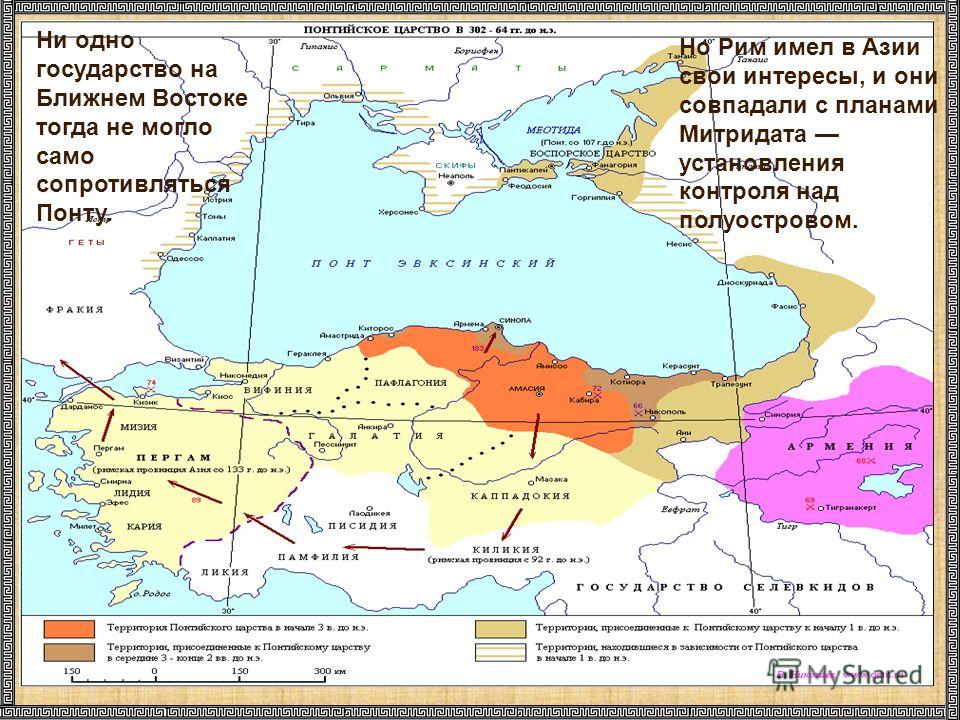
In the Second Mithridates War of 83 BC, neither the Romans nor the Pontians were interested. The Roman proconsul did everything to start the war, but he was defeated in the first battle. After that, neither side sent significant reinforcements to the theater of war. The war smoldered for 2 years, and a peace was signed with Pontus, which in no way changed the positions of the parties. However, neither Rome nor Pontus could tolerate a powerful enemy and were preparing for a future war. During the First Mithridates War (89-84 BC), the Pontians expelled the Romans from Asia Minor and Greece. The third Mithridates war (74-63 BC) went on with varying success. The Pontic army twice defeated the Romans, but Mithridates was unable to build on his success, which was immediately taken advantage of by the Roman governor in the East, Lucullus, and inflicted a series of defeats on Mithridates, ousting the Pontic king from Pontus itself.
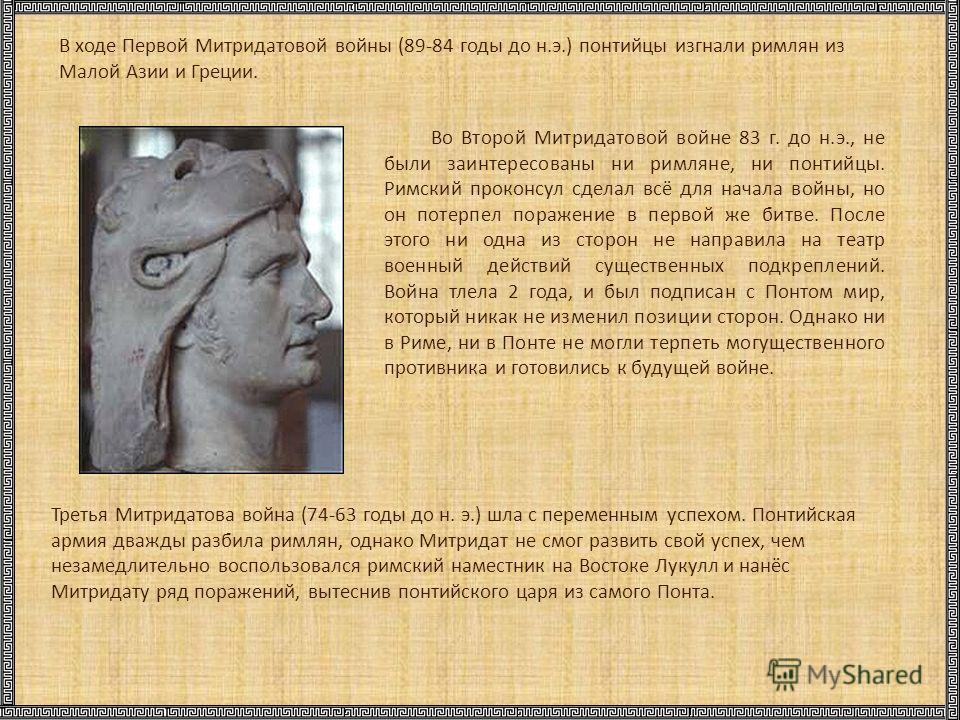
She was strongly influenced by the royal court in Sinop and what happened there during the war. Naturally, there were people at the court who were for the king and against him. Above the courtyard there was a constant threat of war. In addition to rumors and rumors with which the court was full, Cleopatra was strongly influenced by scenes of military life. The children of Mithridates were in the castle. It can be assumed that at the beginning of the war, while the military actions of Mithridates were successful, his children were in the palace. However, after the beginning of his defeats, and especially after the king ordered his wives to poison themselves, the children everywhere followed him along with the army. As you know, at the end of the war, Mithridates Eupator sent out small garrisons to the cities of the Bosphorus, which supported the king. According to the stories of Evdokimov Pavel Andreevich, as a result of excavations on the territory of the Phanagoria acropolis, figures and sculptures were discovered that speak of the worship of Dionysus. As you know, Mithridates bore another Greek name Dionysus, so it is possible to assume that the followers of the cult of Dionysus were his children and the detachment that arrived with them.
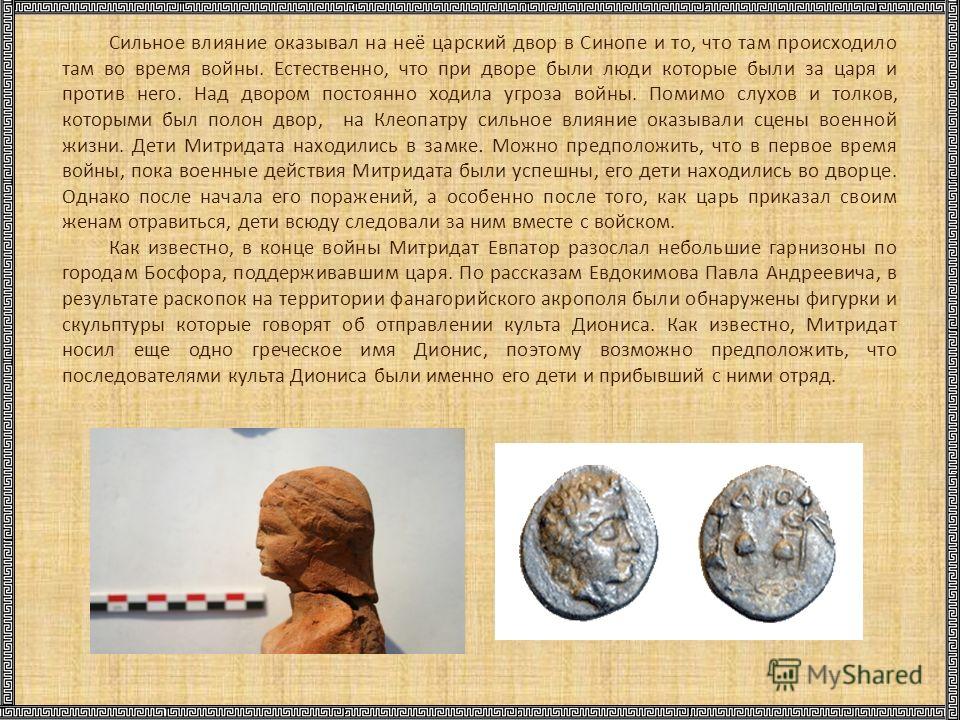
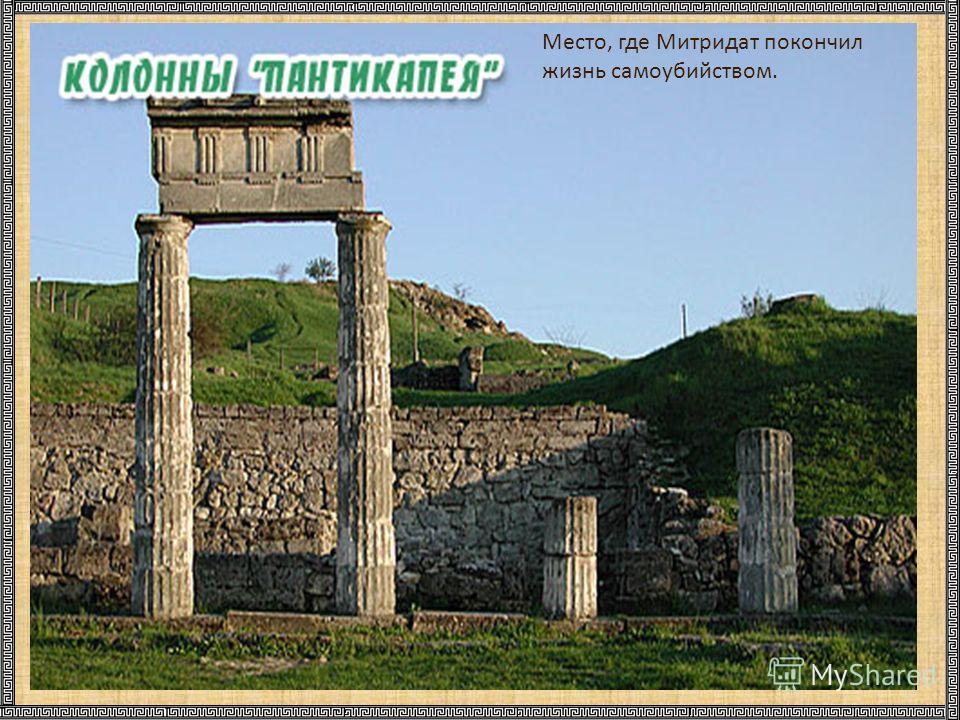
Like every king of those times, he had a large family (wives, sons, daughters). In total, Mithridates VI had 8 daughters known to us from the preserved ancient sources: 1.Dripetina, 2.Cleopatra I, 3.Athenaida, 4.Mithridatis, 5.Nisa, 6.Cleopatra II, 7.Evpatra, 8.Orsabaris. Our project is dedicated to one of the most interesting and mysterious daughters of Mithridates VI Eupator, Cleopatra II.

Cleopatra was a girl of strong physique (we can learn about this from the works of Appian). We can assume that Cleopatra had dark thick hair and a large, wide nose, we can make this conclusion by looking at her father, Mithridates, and other relatives. Most likely, Cleopatra dyed her hair and skin pale, because ideal of beauty in the 1st century BC there was a blue-eyed blonde.

All we know about Cleopatra is Appian's information about the Phanagoria uprising in BC. NS. “Although ... the fortress was already occupied by Artaphernes and the other sons of Mithridates, they surrounded the top of the mountain with a tree and set it on fire. Artaphernes, Darius, Xerxes, Oxatrus, the sons of Mithridates, and Eupatra, his daughter, frightened by the fire, surrendered and allowed themselves to be taken away. Of these, only Artaxerxes was 40 years old, the rest were handsome youths. But Mithridates' daughter, Cleopatra, resisted. The father, delighted with the courage of her spirit, sent a lot of birem, tore her out of the hands of enemies. And those fortifications nearby, which were recently captured by Mithridates, under the influence of such a bold act of the Phanagorians were set aside from Mithridates, namely: Chersonesos, Theodosius, Nympheus and all the others along the banks of Pontus ... Mithridates, seeing frequent falling away and being suspicious of the army, considering it unreliable ... he sent ... his daughters to the Scythian rulers as wives, asking them to come to him with an army as soon as possible. " (Appian, Mithridatic Wars, 108).

It is known about this daughter of Mithridates VI that she was in Phanagoria at the time of the uprising of this city against the king. However, unlike the other children of the king, she was not taken aback and resisted the rebels. Delighted with her courage, Mithridates sent her to help and thereby saved her. The further fate of Cleopatra is unknown. There is no doubt that this woman is not the Cleopatra who was married to the king of Armenia Tigran II - she is another daughter of the Pontic ruler. She may have received the name after the death of the latter, as an adult. If so, then Mithridates was preparing her for marriage with one of the "strong" kings, giving her more weight by replacing her name with a more significant one. Judging by what is written in the source, Cleopatra II was not married, which means that she was about years old. We have no information whether she was married to someone, at that time there was a war, and it was impossible to do this. Therefore, we can assume that Cleopatra was born in the period from 80 to 76 years. This means that she could have been born during the second war of Mithridates with Rome, or soon after. However, we do not know who her mother was. Since she was considered a royal daughter, her mother could not be a simple concubine of Mithridates, only a wife. As you know, only Laodice and Monima held the royal title. With the latter, Mithridates entered into a marriage contract in 88 BC. She appears to be the most likely candidate for the role of Cleopatra's mother. However, Polupudnev suggested that her mother could be Berenice.
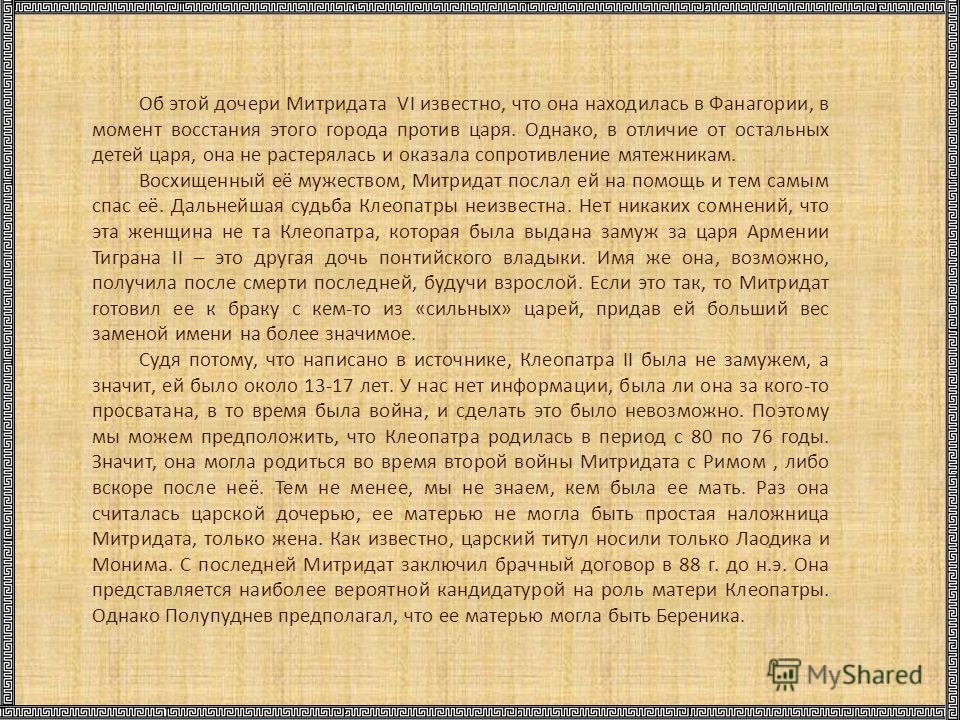
According to the rules of that time, children up to about 6-7 years old were in the female half of the palace, which means that her communication with her father is hardly possible. By the time she could see her father and he could begin to influence her, the third war with Rome began. Therefore, she did not receive information about her father directly. She was strongly influenced by the royal court in Sinop and what happened there during the war. Naturally, there were people at the court who were for the king and against him. Above the courtyard there was a constant threat of war. In addition to rumors and rumors with which the court was full, Cleopatra was strongly influenced by scenes of military life. Children of Mithridates were in the castle It can be assumed that at the beginning of the war, while the military actions of Mithridates were successful, his children were in the palace. However, after the beginning of his defeats, and especially after the king ordered his wives to poison themselves, the children everywhere followed him along with the army.
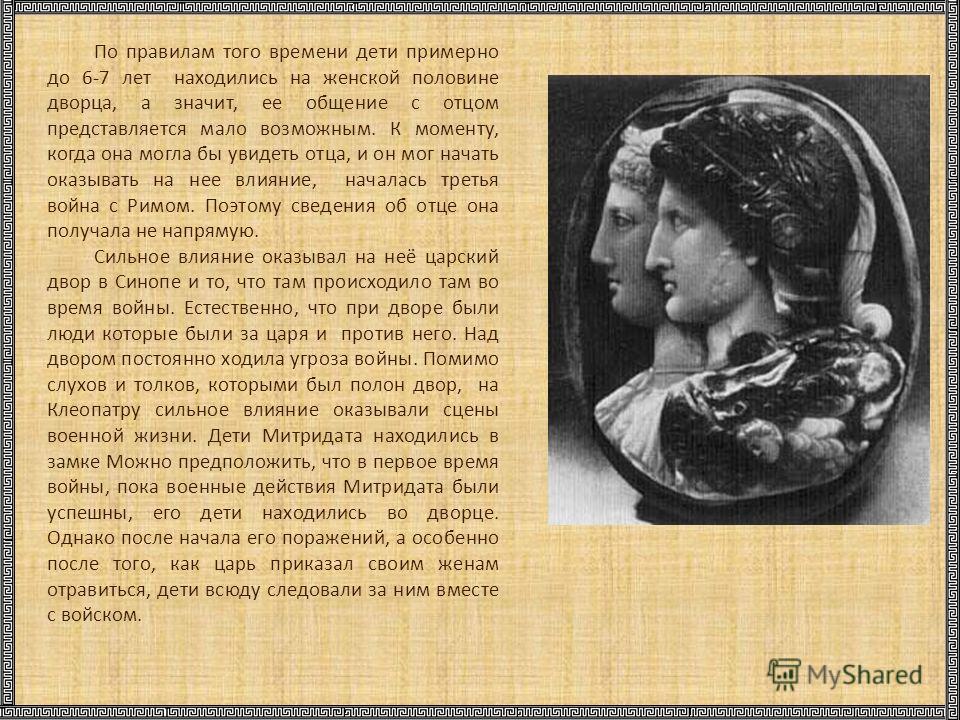
Women wore long hair and knew several types of hairstyles, but the so-called Greek knot - korimbos - can be considered a classic hairstyle. With this hairstyle, long hair was combed in a parted part, curled in waves and lowered quite low on the forehead, since, according to the aesthetic concepts of that time, the forehead should be low. Further, the hair was lowered along the cheeks, and raised from behind and placed in a knot at the back of the head, fastened with hairpins and narrow ribbons. Life after the death of his father. As you know, Mithridates VI was poisoned in the tower of the Panticapaean acropolis, not wanting because of the betrayal of Pharnaces, not wanting to fall into the hands of the Romans. Together with him, for the same reason, his two daughters were poisoned. Judging by the absence of a name, Cleopatra did not fall into the hands of the Romans in the lists of those children of Mithridates who passed in the triumph of Pompey. Therefore, we can only make assumptions about its further destiny... This will be followed by 4 versions of the project participants, about the further fate of Cleopatra: I Perhaps she was with her father before his death. Then she married some ordinary person, retiring from politics. II Possibly poisoned after learning about the death of her father. III She left for a quiet and small town and never married again and had no children. VI Lived with her father until his death, and then left for another city and maybe would have married some person.
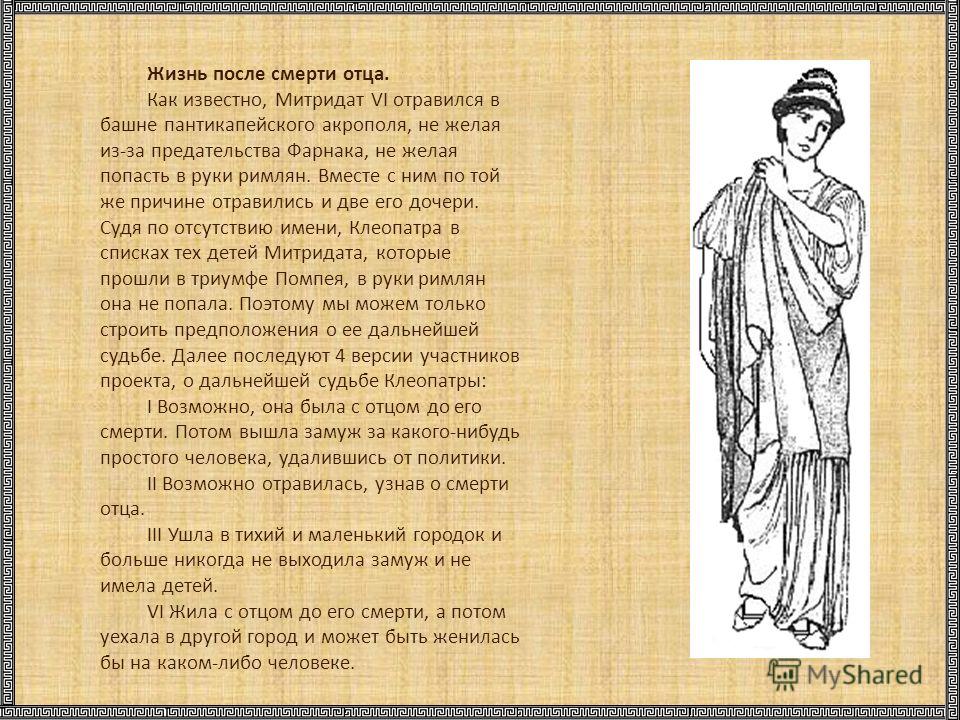
The mystery of the fate of Cleopatra, daughter of MithridatesVIEupator... Everyone knows that when Rome in the 1st century BC. NS. tried to spread his influence (democracy) in the East, he faced a strong rival - the Pontic kingdom. It was headed by Mithridates Eupator VI.
Mithridates VI Eupator
Mithridates VI Eupator Dionysus was born in 132 BC. NS. He traced his ancestry on the father from the Achaemenids, and on the mother - from the Seleucids. The fate of the famous Pontic sovereign commander was not easy. Born in 132 BC NS. Mithridates Eupator traced his ancestry on the father from the Achaemenids, and on the mother - from the Seleucids. He was an energetic and capable man with tremendous physical strength. He did not receive a systematic education, but nevertheless, according to the testimony of his contemporaries, he knew 22 languages, was familiar with the best representatives of the Hellenistic culture of his time, wrote a number of works on natural history and was considered the patron of the arts and sciences. However, along with this, he was distinguished by superstition, cunning and cruelty. He was a typical Asian despot.
The fate of the famous in history Of the ancient world Pontic sovereign commander was not easy. He could not immediately inherit the royal throne that legally belonged to him, because due to the intrigues of his mother and guardians, he had to hide, fearing for his own life. The hardships of adolescence largely predetermined the firmness and decisiveness of character, and the belligerence of Mithridates VI Eupator.
http://pandia.ru/text/79/012/images/image002_23.gif "width =" 155 "height =" 196 src = "> Master" href = "/ text / category / vladika /" rel = "bookmark "> lords. She may have received the name after the death of the latter, already as an adult. If this is so, then Mithridates was preparing her for marriage with one of the "Strong" kings, giving her a more significant weight by changing her name.
She was strongly influenced by the royal court in Sinop and what happened there during the war. Naturally, there were people at the court who were for the king and against him. Above the courtyard there was a constant threat of war. In addition to rumors and rumors with which the court was full, Cleopatra was strongly influenced by scenes of military life. Children of Mithridates were in the castle It can be assumed that at the beginning of the war, while the military actions of Mithridates were successful, his children were in the palace. However, after the beginning of his defeats, and especially after the king ordered his wives to poison themselves, the children followed him everywhere along with the army ..
http://pandia.ru/text/79/012/images/image005_4.jpg "width =" 508 "height =" 303 ">
Sculpture of Dionysus
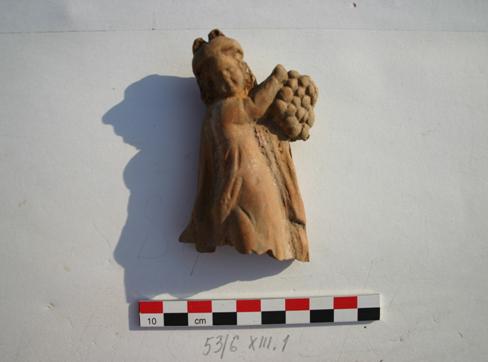
which speak of the worship of Dionysus. As you know, Mithridates bore another Greek name Dionysus, so it is possible to assume that the followers of the cult of Dionysus were his children and the detachment that arrived with them.
The uprising in Phanagoria - as a result of the sending of an additional garrison. Phanagorian Castor - personal scores with the centurion Tryphon, so he raised a rebellion.
Life after the death of his father.
As you know, Mithridates VI was poisoned in the tower of the Panticapaean acropolis, not wanting because of the betrayal of Pharnaces (Pharnaces I (Greek Φαρνάκης) - King of Pontus, who ruled around 190 BC - around 159 BC.
Pharnaces was the son of King Mithridates III. Around 183 BC NS. Pharnaces was able to capture the city of Sinop and decided to strengthen the influence of the Pontic kingdom in Asia Minor, however, a coalition was formed against him, which included; the island of Rhodes, Ariarat IV is the king of Cappadocia, Prusius II is the king of Bithynia, and Eumenes II is the king of Pergamum. In 181 BC. NS. the Pontic army invaded Galatia, but hostilities were soon suspended with the arrival of the Roman delegates. However, the original demands of Pharnaces were rejected by the Roman Senate, after which he decided to resume hostilities. However, the Pontians were unable to overpower the combined forces of their opponents, and in 179 BC. NS. Pharnace decided to open negotiations for peace. According to the peace treaty, the Pontic kingdom lost its conquests in Galatia and Paphlagonia, but retained Sinope. Pharnaces continued to rule until the middle of the 2nd century, and after his death the throne passed to his brother, Mithridates IV.)
fall into the hands of the Romans. Together with him, for the same reason, his two daughters were poisoned. Judging by the absence of the name Cleopatra in the lists of those children of Mithridates who passed in the triumph of Pompey, she did not fall into the hands of the Romans. Therefore, we can only speculate about its future fate.
We can guess what happened to Cleopatra after her father's death.
Version 1. Angelina Goryacheva: She could not go to the people, because they would immediately recognize her. She could not marry Pharnaces, a traitor to her father. Either married a familiar Persian, or ended her life by suicide.
Version 2. Sokolova Anastasia: She died of natural causes, because until the death of her father she was with him all his life, and after his death she left. Where??
Version 3. Vasilchenko Elena: Was with my father until his death. Then she married some ordinary person, retiring from politics.
Version 4. Mary of the Epiphany: Poisoned after learning about the death of her father.
Image of Cleopatra
Cleopatra was a girl of strong physique (we can learn about this from the works of Appian). We can assume that Cleopatra had dark thick hair and a large, wide nose, we can make this conclusion by looking at her father, Mithridates, and other relatives. Most likely, Cleopatra dyed her hair and skin a pale color, since the ideal of beauty in the 1st century BC. NS. there was a blue-eyed blonde.
Cleopatra was dressed in fashion, in white linen clothes, painted in the most incredible way.
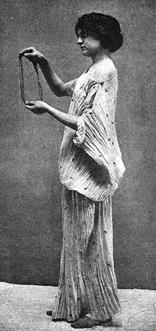
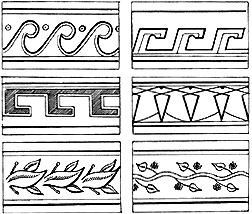
Literature:
Appian http: // www. / istoriya / rim / appian / mitridat. html
Library (information about the Mithridates warriors)
According to available information, Mithridates was born in 132 BC. Mithridates Eupator traced his ancestry on the father from the Achaemenids, and on the mother - from the Seleucids. He was an energetic and capable man with tremendous physical strength. He did not receive a systematic education, but nevertheless, according to the testimony of his contemporaries, he knew 22 languages, was familiar with the best representatives of the Hellenistic culture of his time, wrote a number of works on natural history and was considered the patron of the arts and sciences. However, along with this, he was distinguished by superstition, cunning and cruelty. He was a typical Asian despot.
The fate of the Pontic sovereign-commander, famous in the history of the Ancient World, was not an easy one. He could not immediately inherit the royal throne that legally belonged to him, because due to the intrigues of his mother and guardians, he had to hide, fearing for his own life. The hardships of adolescence largely predetermined the firmness and decisiveness of the character and belligerence of Mithridates VI Eupator.
In 113 BC. NS. Mithridates with his supporters returns to Pontus and asserts his royal power over the country.
However, he managed to achieve this only after a ruthless bloody reprisal against enemies from the Pontic nobility. At his court, secret murders of people became commonplace. Only after such a prologue of accession to the kingdom, the aristocracy of Pontus recognized him as a full sovereign.
Mithridates VI Eupator began his long reign with the creation of a strong Pontic army, at the head of which he intended to make great conquests. Indeed, very soon the warlike king of Pontus subdued neighboring Colchis by force of arms, turning it into a Pontic satrapy, and Lesser Armenia, Tauric Chersonesos, which was provided with protection from the Scythian kingdom and part of the Scythian sedentary tribes in Tavria. Alliances were concluded with the free tribes of the Scythians, Bastars and Thracians.
The Bosporan king, the last representative of the Spartokid dynasty, renounced power in favor of the Pontic king Mithridates Eupator. At that time, a powerful uprising of slaves and the poor took place in the Bosporus kingdom under the leadership of Savmak, who managed to retain power for a year. The troops of Mithridates Eupator, having made a campaign in the Northern Black Sea region, suppressed the uprising of slaves in the Bosporus kingdom, which became part of the Pontic kingdom.
Now the Bosporan state was located on the banks of the Black and Azov seas and waged long, and not without success, wars with the mighty Ancient Rome.
The Greek states and the Bosporan kingdom gave Mithridates Evpator a lot of money, bread, fish and other food for his army. The "barbarian" peoples who lived to the north and east of the possessions of Pontus regularly supplied mercenaries to the royal army.
Mithridates dreamed of creating a powerful state in all respects, capable of becoming the successor of the Hellenistic dynasties. Its influence on eastern borders He asserted Rome not only by force of arms, being a subtle diplomat and purposeful politician. So, he married his daughter to the Armenian king Tigran and could hope, if necessary, for the troops of his son-in-law. Mithridates Eupator was able to establish peaceful relations with the leaders of the nomadic Scythian tribes, with whom the Pontians conducted a lively trade.
However, on his way, the ruler of the Bosporus kingdom saw a formidable obstacle - the Roman expansion to the East. Mithridates VI Eupator decided to assert his dominant position not only in Asia Minor, but also in the adjacent territories, primarily in Greece.
He began the solution of such a difficult task with the creation of powerful armed forces of the Bosporus kingdom - the army and the navy. Mithridates Eupator managed to collect a huge army for that time (according to ancient sources, greatly exaggerating its real number) of 300 thousand people. The army was hired and the tsarist treasury had large funds for that, thanks to the stably collected taxes in the Pontic state.
According to ancient sources, the military fleet of Mithridates consisted of up to 400 warships built by local shipbuilders.
The creation of such an armada was possible because among its subjects there were a sufficient number of merchant sailors and fishermen, because fish, salted and felted, was one of the country's main export items. A large number of ships made it possible to transport thousands of troops to the southern Black Sea coast and wage a war against a strong Roman fleet.
In the spring of 88 BC. NS. the Pontic king invaded Roman Asia and easily captured it. The conquest of the Roman provinces of Bithynia and Cappadocia was accompanied by a terrible massacre of the Romans and Italians who lived there (residents of the Apennine Peninsula who were not citizens Of the eternal city). The indigenous population welcomed the arrival of Mithridates on their lands, who acted as the liberator of Asia Minor from Roman rule. The rule of the Eternal City lay with a heavy burden on the peoples conquered by Ancient Rome, and they constantly rebelled against it.
The Pontic ruler, after rather easy victories for him in Asia, led his army and navy to the west. The Pontians moved through Macedonia to Greece. The alarm was sounded in Rome, and a large army was assembled under the command of the consul Sulla to repel the invasion of the army of Mithridates. However, the civil strife that broke out in the Eternal City postponed the campaign of the Roman army to the east, to Greece.
During the First Mithridates War (89-84 BC), the Pontians expelled the Romans from Asia Minor and Greece, defeating in several battles such famous generals of Ancient Rome as Cassius, Manius Aquilius and Oppius. King Mithridates more than once demonstrated high military leadership in front of his opponents and became one of the most hated enemies of the Eternal City.
However, the First Mithridatic War began in defeat for the Pontians.
In 88, the tsarist army laid siege to the Asia Minor city of Cyzicus and, unexpectedly for itself, found itself surrounded by the Romans under the command of Lucullus. But this commander did not decide on a general battle with Mithridates Eupator, although in numerous skirmishes with the Pontians, the Roman troops (according to their written testimonies) inflicted considerable damage on the enemy.
At this time, the consul Sulla successfully launched a military campaign in the east. In mid-87, his legions disembarked from ships in Greece, which sided with Mithridates before he came to Greek soil, and laid siege to Athens. The Roman army after a long effort by the spring of 76 BC. NS. took the city, which was trying to throw off the foreign yoke with the help of Pontus.
Unlike Asia Minor, Mithridates in Greece was plagued by military setbacks. Here he had a strong opponent in the person of the ambitious commander Cornelius Lucius Sulla. In addition, the proximity of Greek territory to the Apennines allowed Rome to constantly build up its military forces in Greece.
The army of Mithridates under the command of Archelaus and Aristion, passing through Macedonia, entered Greece proper only when Athens was taken, on a military alliance with which the Pontic king had pinned great hopes. In addition, now, in addition to Sulla, he had here another strong enemy who came from Rome - a large army of the Marians, led by Valerius Flaccus, who also wanted glory and military booty.
In 86 BC. NS. Cornelius Sulla defeated the troops of King Mithridates in two battles - at Chaeronea and Orchomenes. In the first of them, the Roman commander commanded a 30-thousandth, well-trained and disciplined army. The 90 thousandth Pontic army, which had 90 war chariots, was commanded by the tsarist commander Archelaus, who was never able to use numerical superiority in the battle. At the Battle of Chaeronea, the commander Sulla, for the first time in world military practice, used a well-thought-out system of field fortifications.
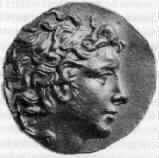 |
He defended himself from the Mithridates cavalry with ditches, and from the chariots of war - with a palisade. The Roman legions, having withstood the first onslaught of the discordant ranks of the enemy, themselves went forward and won a convincing victory.
Under Orchomenos, the opponents - Sulla and Archelaus - met again. At the very beginning of the battle, the Pontic cavalry dealt a strong blow to the Roman soldiers lined up for battle and pushed them back. However, the experienced Sulla showed himself from the best side in such a critical situation. He was able to collect the troops that were starting to retreat for a retaliatory strike and defeat the Pontic army.
King Mithridates VI Eupator himself was defeated in the same year by the Roman commander Flavius Fimbrius in the battle of Miletopolis. The victory of the Roman arms was complete. After these defeats, the army and navy of Pontus left the territory of Greece, which was again taken over by the Romans. Victory was celebrated with great festivities in the Eternal City.
Mithridates hoped to gain a foothold in Asia Minor in order to start new military operations against Rome from there, but events got ahead of him. In Greece, where the army of the Marians was stationed under the command of Valerius Flaccus, a soldier's revolt broke out. The commander-in-chief was killed, and in his place the soldiers elected the leader of the rebellion, Gaius Fimbrius. He moved to Asia Minor and, in the battle of Propontis, defeated the Mithridatic army, which was beginning to rebuild its strength.
The situation among the many Greek islands in the Aegean Sea. Here the strong military fleet of Ancient Rome already reigned supreme, ousted the weaker, albeit numerous, Pontic fleet through the straits to Black Sea.
King Mithridates VI Eupator asked for peace, which was concluded in August 85 BC. NS. in Dardan. The Pontic monarch liberated all the territories occupied by his army, primarily the regions in Asia Minor, and paid an indemnity to Ancient Rome in the amount of two thousand talents. After the conclusion of peace, Mithridates, being defeated, managed to retain his main possessions. However, his relationship with the ruling circles of the Eternal City remained extremely tense.
The Second Mithridatic War (83-81 BC) was provoked by the Roman proconsul Licinius Murena, an ambitious man who dreamed of becoming famous in the military field. However, the Roman troops were defeated by the Pontians. The fragile peace between the mighty Rome and the Kingdom of Pontus was disrupted by a seemingly minor military incident.
Mithridates Eupator, well aware of the inevitability of a new military clash with Rome, began to vigorously prepare for a new war with him.
He, a brilliant diplomat of the Ancient world, managed to create a powerful military coalition against Rome, which included the Scythians, Sarmatians, Thracians, Germans, as well as the troops of Sertorius in Spain, the king of Armenia Tigran II and pirates (Cilicians) Mediterranean Sea... In addition, according to some reports, King Mithridates supported the uprising of slaves in Rome led by Spartacus.
In 75 BC. NS. Nicomedes, king of Bithynia, bequeathed his kingdom to Rome.
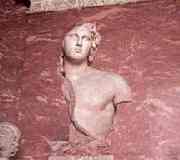 |
But his possessions on the southern Black Sea coast of Asia Minor bordered on the Pontic kingdom. Mithridates foresightly saw in this primarily a military threat to his possessions and the lands of his allies. In addition, he himself claimed the possession of Tsar Nicomedes. In 74 BC. NS. his 120,000-strong army with the support local population invaded Bithynia, dependent on Rome, and took possession of it. At the same time, a war began against the Romans of Cappadocia and Paphlagonia.
This Third Mithridatic War (74-63 BC) went on with varying degrees of success. In ancient Rome, they took the events in Asia Minor Bithynia seriously and moved there numerous troops and a fleet, which had previously cleared the Mediterranean from the pirates of Cilicia. The consul Lucius Licinius Lucullus was appointed commander-in-chief in the East, with whose name the first significant military successes of Roman weapons in the new war against the Pontine kingdom are associated.
Initially, the Romans were defeated. Near the city of Nicopolis, the Roman commander Domitius Calvin, having under his command one legion and auxiliary troops recruited in Asia Minor, faced the Pontic army, led by the royal son Farnak. After the first onslaught of the enemy, the Asiatic allies of the Romans fled from the battlefield, and only the staunchness of the Roman legion prevented the defeat from assuming catastrophic proportions.
A major naval battle took place in 74 at Chalcedon. The Roman fleet under the command of Rutilius Nudon, when the Pontic fleet appeared at sea, tried to leave the harbor and line up in a battle line. However, the Pontians pushed the Romans back to the fortified harbor of Chalcedon. It seemed that this was the end of the naval battle.
However, the Pontians thought differently from their adversary. They destroyed the enemy barriers at the entrance to the Chalcedonian harbor, into which their warships immediately burst. In the course of fierce boarding battles, all 70 ships of the Roman naval commander Rutilius Nudon were destroyed.
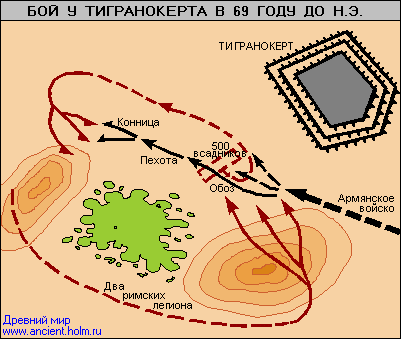 Battle of Tigranokert in 69 BC (map from the project "Ancient World") |
This was a powerful blow to the Roman sea power, which was one of the reasons for the protraction of the Third Mithridate War.
After these events, the consul Lucullus inflicted several defeats on the troops of King Mithridates Eupator, skillfully using all the advantages of a modern, well-trained and disciplined Roman army. Mithridates was driven out by the enemy from Bithynia and Pontus. Lucullus forced him to flee to his son-in-law, Tigranes of Armenia. The latter's refusal to hand over his father-in-law to the Roman consul was the reason for the war between Rome and Armenia.
In the fall of 69 BC. NS. The 10 thousandth Roman army under the command of Lucius Licinius Lucullus laid siege to the city of Tigranokert. The besiegers were attacked by a 100,000-strong Pontic army under the command of King Tigran of Armenia. But at the very beginning of the battle, he did not manage to occupy the hills that would protect the positions of his cavalry. The consul Lucullus took advantage of this, skillfully attacking the Pontic cavalry from the rear and defeating it. After this, the Roman legions attacked the enemy infantry and also defeated it. According to Roman sources, who clearly exaggerated the victory of the Roman army at Tigranokert, the Pontians lost about 100 thousand people, while the winners themselves - only 5 (five) people!
In the next 68 BC. NS. the victor Lucullus marched at the head of the Roman army to the capital of Armenia Artaxatu (Artashat), but his campaign was unsuccessful. Mithridates Eupator's response was not long in coming - he went on the offensive with his troops, having won Pontus and Armenia from the Romans.
At the beginning of 66 BC. NS. command of the Roman army in the East passed to the commander Gnaeus Pompey. In the same year, the second battle in history between the Romans and the troops of King Mithridates took place near the city of Nikopol.
Pompey managed to occupy the heights dominating the battlefield, and the Pontians had to camp under them. At night, the Roman legions suddenly attacked the sleeping Pontians and defeated them, putting the royal army to flight.
After this battle, Mithridates was finally driven out of his dominions. He had to flee first to Colchis, and from there through the Black Sea to the capital of the Bosporus kingdom, the city of Panticapaeum (modern Kerch). There he decided to gather his strength and start a war again against the hated Rome. However, the fugitive Pontic king did not receive support from the people and the army.
Soon, they rebelled against Mithridates VI Eupator Greek cities Northern Black Sea and Azov coast. A revolt against the sovereign was also raised by the royal army, led by his son Pharnacs. Then, in 63 BC, King Mithridates committed suicide by throwing himself on the sword, not wanting to surrender to the enemy. (According to other sources, the Pontic king ordered a slave to stab himself with a sword.) Thus, he avoided humiliation from the victors.
The result of the Third Mithridates War was the transformation of Bithynia and Pontus into Roman provinces. Following this, the commander Pompey, at the head of the Roman army of many thousands, approached the Armenian capital Artaxata and forced the king Tigranes to recognize himself as a vassal of Rome and abandon all his conquests in his favor. The death of Mithridates Eupator led to a significant expansion of the possessions of Ancient Rome in Asia Minor.
Used sources.
1. They were called the Great / otv. ed. Roginskaya G.Yu. - Kharkov: Light-Press, 2000.
2. Shishov A.V. 100 great generals. - Moscow: Veche, 2000.
3. The World History wars. Book one. R. Ernest and Trevor N. Dupuis. - Moscow: Polygon 1997.
4. World history. Roman period. - Volume 6 - Minsk: Contemporary Writer, 2000.




